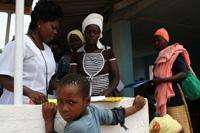Latest Research Shows Expanded Treatment Could Turn AIDS Tide
Now that research has shown that HIV treatment can reduce transmission by 96 percent, governments meeting at the UN Summit on AIDS must agree to put nine million people on treatment over the next four years.
NEW YORK, June 6, 2011 – At a time when HIV treatment has been proven to dramatically reduce HIV transmission by 96 percent, governments meeting at the UN Summit on AIDS must agree today to put nine million people on treatment over the next four years, despite strong opposition from several key funders, the international medical humanitarian organization Doctors Without Borders/Médecins Sans Frontières (MSF) said today.
“After weeks of contentious negotiations, will governments today sign up to a proposed target to have 15 million people on HIV/AIDS treatment by 2015?” asked Sharonann Lynch, HIV/AIDS policy advisor for MSF’s Campaign for Access to Essential Medicines, speaking at a press conference at the UN in New York. “The world needs an ambitious HIV/AIDS treatment target with a plan attached to make it a reality – because it will be meaningless if countries aren’t willing to come up with the cash and actions needed to break the back of the epidemic.”
The summit comes on the heels of fresh scientific evidence that shows that treatment is a form of prevention, as it reduces transmission of the virus from one person to another by 96 percent.
“Over the last ten years, we’ve watched treatment save lives, and now we know it can also protect entire communities, because treatment is prevention,” said Dr. Tido von Schoen-Angerer, executive director of MSF’s Campaign for Access to Essential Medicines, who worked in MSF’s first HIV/AIDS treatment project in Thailand. “You’d have to be out of touch with reality not to want to turn this landmark evidence about HIV treatment into policies that will get ahead of the wave of new infections. Countries meeting in New York have the power to change the course of the AIDS epidemic.”
An additional $6 billion will be needed each year by 2015 to help avert twelve million new infections and more than seven million deaths by 2020, according to new research by UNAIDS. This would also help bring the number of annual infections down from 2.5 million in 2009, to one million by 2015. However, funding in 2009 and 2010 declined, leaving the Global Fund to Fight AIDS, TB and Malaria, the US-government’s PEPFAR program, and other programs, short of needed resources to make use of the benefits of "treatment as prevention."
Governments also need to ensure the cost of medicines remains affordable. Increased patenting of medicines is already impacting access to the newer HIV/AIDS medicines needed to treat people as they navigate the life-long disease.
Newer drug combinations can cost nearly 50 times as much as the first generation of drugs. Countries must immediately stop pushing trade policies that block the production, export, transit, and importation of more affordable generic medicines, MSF said. Such policies are part of a number of new bilateral free trade agreements, such as one currently under negotiation between the European Union and India.
“Ten years ago, our patients came to clinics in wheelbarrows, often moments away from death, because treatment was priced out of reach,” said Dr. von Schoen-Angerer. “Thanks to affordable generic drugs, we’ve watched treatment transform lives. Rich countries need to stop the double-speak of claiming to tackle HIV/AIDS when at the same time they are pushing policies that will block the price-busting generic competition needed to get more people on treatment for life.”
Governments must also stop opposing the implementation of strategies directed toward groups most vulnerable to the epidemic: women; men who have sex with men; people who inject drugs; and sex workers.
“It’s way past high time for leaders to get their heads out of the sand when it comes to the most marginalized groups affected by this plague,” said Nonkosi Khumalo, chairperson of the Treatment Action Campaign in South Africa. “Treatment and prevention strategies targeting the most at-risk groups are irrelevant if you deny these people’s very existence.”
MSF currently provides antiretroviral treatment to 170,000 people living with HIV/AIDS in 19 countries and sources more than 80 percent of the antiretroviral medicines it uses in its projects from generic manufacturers in India.
To read MSF’s report, “Getting Ahead of the Wave: Lessons for the Next Decade of the AIDS Response,” visit:Treat AIDS. Stop the virus





